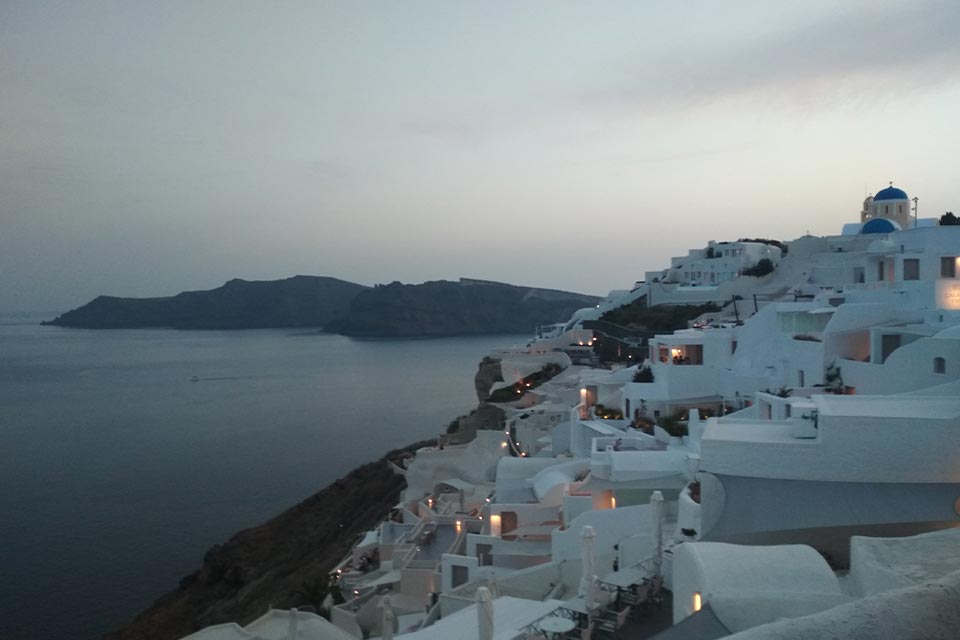The Analog Serenade of Santorini

Though Santorini is a place where the sensory gets top billing, it’s an island of sweeping contrasts. After an extended stay, Baret Magarian explores its history, sights, and contemporary challenges.
The mind-numbing paradox inevitably strikes anyone who reads about the origins of Santorini. After a series of volcanic eruptions dating back to antiquity, one particular eruption of cataclysmic force in around 1500 bce eventually gave rise to the most ethereal archipelago of islands in the Aegean, whose phantasmagorical beauty seduces cynics and romantics alike. Destruction and creation have rarely been so closely entwined.
It’s hard to convey to the uninitiated the incredulity that the first glimpse of Santorini induces in the onlooker. There is a kind of tug-of-war going on between the reddish-black landscapes and unscalable cliffs that were spewed out from the white-hot lava of the volcanic eruptions and the purity of the igloolike blue and whitewashed cave houses that reach skyward in steep gradients, appearing like human-made extensions of the sheer, looming rock face. The predominant feeling you have as you first clap eyes on the villages of Oia and Thira from a distance is that it is hard to imagine that something so beautiful could have been wrought by human ingenuity, structures hewn into the yawning cliffs at impossible vertical angles, as though in defiance of the laws of gravity.
The fact that one can more or less discern the entire archipelago of five islands in a 360-degree arc at elevated points lends the observer a perspective that is detached, unfiltered, cosmic. The line of the horizon is defined in breathtaking precision, and, beyond the crescent of islands, all that one perceives is the infinite expanse of sea and sky seamlessly fused, freed from any sense of land’s shroudedness. The slow movement of distant ships as they carve incisions into the gelatinous water offers anyone patient enough to monitor them a nonverbal meditation on time and motion.
There is a wonderful semicircular dust road that winds from Oia to Thira, the capital, and I braved the elements on a rented Vespa this way many times. On your left, a vertiginous abyss terminating in the Aegean; on the right, gigantic prehistoric-looking boulders strewn with asymmetric cacti and vegetation. The whole interface of land and water, road and boulder hums with an almost palpable energy, and the twenty minutes that elapse as you head into Thira are strangely nonlinear. The presence of the sinewy crosswinds and the marked sense of one’s smallness against the massive backdrop of the elements bring you up close to the frontiers of your own insignificance; time then seems to dilate and contract in strange ways as you round more and more bends. Thira appears far off and out of reach as you sight its white apex from afar, and then, all of a sudden, you are upon it, as if in a dream.
En route you pass an exquisitely shambolic roadside café, which has gestated out of what looks like the remains of a caravan, inside which aromatic coffee and nut cakes percolate and bake. A makeshift roof of slanting wooden beams offers scant protection from the corrosive yet recalibrating sunlight. This has become my favorite place on the planet. Herein lies the most striking of juxtapositions: on one hand this view of Olympian grandeur—a prodigious mixture of air, earth, light, and water held in synthesis, the quintet of islands casting a spell over your senses—and on the other hand, this humble, crumbling shack of a pit stop, melted by time and sun, offering the most rudimentary of settings for the grandest of epiphanies to unfold in. But only those willing to be courted by the analog serenade of this island will be the richer for it, not so those digital zealots who have dumped the habit of seeing reality unless it is through a screen first.

Only those willing to be courted by the analog serenade of this island will be the richer for it, not so those digital zealots who have dumped the habit of seeing reality unless it is through a screen first.
The island is a place of sweeping contrasts. Among these backdrops of natural splendor there are also landscapes of monolithic dryness and eerie ghost towns. One such town, Mesa Gonia, was devastated by an earthquake in 1956, which led to its destruction and abandonment. I snooped around this village and tried in vain to glimpse inside the impressive Byzantine church, the Panagia Episkopi, which still stands there, but it was barred. This crumbling village nonetheless has something spellbinding about it: the notion that all observers of it are somehow happening upon a piece of history frozen in time. No shop, no taverna, no bar, no bank, no supermarket, no store, no ATM, no aerial, no satellite dish. No inhabitants, just stray dogs and cats materializing now and again and then dissolving into the ether of the sunbaked afternoon. Heat seems to define everything, slow everything to a low pulsation, and there is no sound to puncture the crepuscular silence. As I walk further and further into the village’s heart, I half expect some crazed-by-the-sun hermit to accost me.
By contrast, the comparably sized village of Finikia is golden sunrise to Mesa Gonia’s lunar eclipse, all shimmering candles, pink and russet façades, mysterious alleys with enticing blue doors, enchanted vistas, and secreted, tucked-away tavernas. The village is a benign maze of pathways and side streets leading to its epicenter: the church of Agia Matrona with its famed and intricate bell tower.
Of course, such beauty does not come without its problems. The presence of gargantuan cruise ships anchored in the caldera’s thirty-two-mile-wide basin creates overcrowding on the island and in the towns. Guests live and gorge themselves on the cruise ships, only venturing to the island to take photos (to upload to Instagram, no doubt) and to shop and then return to their ships’ bubble existences, never really interacting with the island or experiencing it in anything other than this superficial manner. The overcrowding in the summer months that results from this massive eruption of passengers also makes it less appealing for those actually staying on the island to go out and spend money and thus contribute to the health of the local economy. This in addition, of course, to the environmental hazards posed by such gigantic ships. A large cruise ship can leave a carbon footprint larger than that of twelve thousand cars, as well as dumping toxic waste in the oceans on a scale difficult to imagine.
Then there is the refugee crisis of which the Greek islands have had to bear the lion’s share, alongside Italy and Sicily. Lesbos, Samos, and Crete have been continually inundated with refugees fleeing Libya, Afghanistan, Syria, and the Middle East, and these islands, with their modest resources and extremely limited space, have struggled to cope with the excessive numbers of people trying to start a new life, desperately fleeing war-torn and totalitarian regimes. On Santorini, tourists and holiday makers are carefully spared any glimpse of the harsh reality of the refugee desperation on its sister islands in order for their experience of getting away from it all not to be undermined. Santorini and Mykonos, probably the two most lucrative islands, are more or less given free rein by the Greek state to act like independent kingdoms, and these islands don’t want their exoticism and commerciality tarnished by the presence of real-life problems, struggle, overcrowding, and the stretching of resources associated with the refugee crisis.
The locals I spoke to also emphasized that Greeks themselves often struggle to afford housing and everyday expenses and have to live quite frugally. In winters, the waiters and hospitality workers are unemployed, but in the summer months they work like slaves, often for fifteen or sixteen hours a day. They rarely get to have a day off or hardly ever enjoy the many beaches of the island. The famous Red Beach is the most populous and crowded of the many stretches of shore, resembling a watery and miniature Grand Canyon. Then there is the Kamari Beach, which is accompanied by a two-mile stretch of somewhat gaudy promenade where you can find the usual emblems of secondary gastronomic transposition (English breakfasts, Italian ice cream, American hot dogs). If you so desire, you can take a ferry to deposit you on the other side of the Mesa Vouno boulder that otherwise bars entry to Perissa Beach and seems to have landed from the sky like the fragment of an asteroid.
Then there is the famed marble walkway of Oia, perhaps the most obvious candidate for the loveliest jewel in the island’s crown. This stretch of white marble pavement is framed on one side by elegant shops and restaurants and, on the other, by the sight of the caldera, its collapsed volcano craters all but submerged by a halo of surrounding blue-green sulfurous water. You can sense your center of gravity, inviting you to conjoin with a reality infinitely greater than yourself—impassive, timeless, and the closest you can get in this terrestrial sphere to the ideal, unalloyed realm of Plato’s forms, which he posited as existing somewhere in space-time.

You can sense your center of gravity, inviting you to conjoin with a reality infinitely greater than yourself.
At the end of it all, after the Vespa rides and sunsets, the ouzo and baklava, there is just enough time to catch a moment of peace as you slip exhausted into the magnificent Greek Orthodox church of Thira and light a candle. Outside, small bells chime, signaling the arrival of a cluster of benign and good-natured donkeys. These wonderful animals are now starting to be treated by the islanders with a growing awareness of their sensitivity and intelligence, as they have for too long been exploited and handled harshly.
I hope that modernity will never quite catch up with Santorini, for the island offers a refuge from the excesses and madness of contemporary life and society. As I bid farewell, Santorini still whispers its ancient mantras, reminding us that true sensory experience can never be matched by the facsimiles of the virtual world, which grow ever more ubiquitous.
Florence













